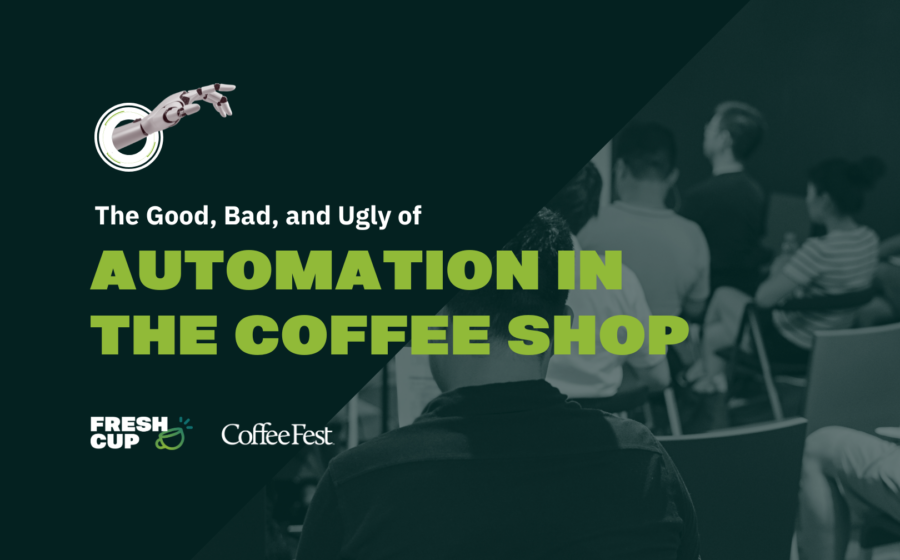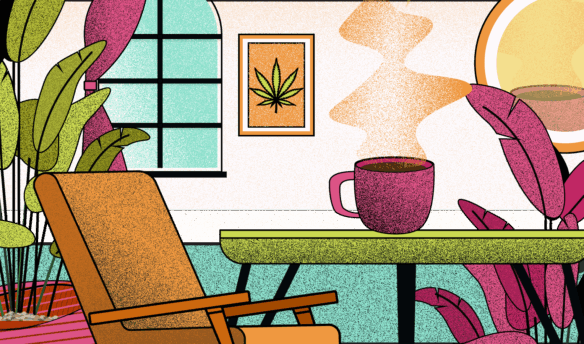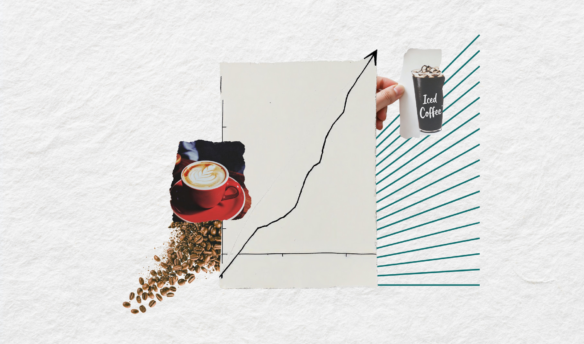Perhaps the most fascinating—and potentially divisive—panel Fresh Cup hosted at Coffee Fest New York, which took place in March of 2023, was about automation.
Automation in the coffee industry has drawn much attention, both positive and negative. We asked our panelists questions like:
- Do machines actually allow baristas to interact more meaningfully with customers?
- Can automation improve quality and accuracy in brewing?
- Where does it make sense to implement automation? And where are we intentionally harming people who work for us?
We couldn’t have asked for a more stellar panel, including:
Nigel Price, Founder of drip coffee makers
In 2018, Nigel began hosting pop-ups across Brooklyn and Manhattan as a coffee cart. In January 2020, drip coffee makers opened its first brick-and-mortar location; three years later, there are four locations throughout New York City.
Anne Mercer, Co-Founder of Victus Coffee
Victus Coffee is a specialty coffee roasting company based in West Hartford, Conn. She also handles communications, green coffee operations, and more for J.René Coffee Roasters, also in West Hartford. She’s also a freelance writer in the specialty coffee space and has covered stories on automation for us at Fresh Cup.
Stephen Welch, Coffee Development Manager, Pret A Manger
Stephen has worked in the coffee industry for over a decade in various retail, wholesale, and importing roles. He currently manages the Coffee and Beverage program for Pret á Manger North America.
Here are key insights from our discussion:
Automation Doesn’t Eliminate The Need For Human Input
“I’m all for automation, as long as it doesn’t impact the quality of the coffee itself,” says Price. He notes that people are still vital: you can go into a coffee shop with all the best equipment and still get bad coffee. Baristas still have to know what makes a coffee taste great and how to use the machines before them to achieve the desired outcome—business owners can’t just put in machines and call it a day.
Mercer says baristas are taught how to make decisions about brewing, like what grind setting to use and how to set coffee-to-water ratios. “Automation helps you do your job rather than trying to replace you.”
At Victus, Mercer focused on two pieces of equipment: the Marco SP 9 automatic pour over machines and the ACE brewer by Brew Bot for cold brew. “And when we approached this whole project, we had three things in mind: the barista experience, the customer experience, and price. From a barista’s experience, they still need to dial in, and these technologies do not take away from the coffee knowledge that they’ve learned and use every day.”
One audience member asked about the perception of value with automation: even if barista training and education is high in stores with lots of automation, will customers devalue their work? Welch says upgrading their machinery improved customer perception (they switched from Cimbali machines to Eversys systems). He does note you might still be fighting long-held ideas about where quality comes from, but that’s a challenge he’s excited to meet.
Automation Can Help Cafés Focus On What’s Important
A common argument for automation is that baristas can focus more on engaging with customers—but this argument is even more multi-faceted. Automation doesn’t just free up baristas; new gadgets and technologies can be a focal point of a cafe and a topic of discussion.
Mercer had two of her employees in the audience who could attest to this fact: “Customers can ask us, ‘What is that? What does that do? Why do you use it?’ I’ve got two of our baristas here in the front row. And they can attest to this, too: automation allows them to have that conversation without detracting from their work. We’ve all been in the position where you’re making a pour over, and a customer asks all these questions, and you want to answer them—and then next thing you know, you’ve gone 400 grams over in the water, and the pour over is ruined.”
If you’re hired at our shop, you’re gonna learn the ins and outs of specialty coffee—automation isn’t made to replace that; it is meant to aid in bar flow. Anne mercer, Victus Coffee
Victus Coffee doesn’t have WiFi, which also influenced Mercer’s decision to invest in automation—baristas create and curate a more intentional, sit-down experience than some shops that attract remote workers, so finding ways to free up their time was deliberate.
At drip, Price highlights pour over coffee, so automation on the espresso side helps emphasize pour over coffee without sacrificing espresso quality. “You have to make those judgment calls based on what you’re trying to convey to each customer. I wanted them to know that the pour over is the focal point.”
Hand Made and Automated Systems Aren’t Mutually Exclusive
Even though drip focuses on pour over coffee, Price still serves batch brew. “We weren’t even going to have a batch brewer until maybe a month before we opened the first location. But I didn’t want to exclude any people who were new to coffee, to anybody who was walking off the street—I didn’t want anybody in the neighborhood to feel like, ‘Oh, this shop is not for us; it’s for the new people coming into the neighborhood.'” To go further, Price notes that people are still vital: you can go into a coffee shop with all the best equipment and still get bad coffee.
We weren’t even going to have a batch brewer until maybe a month before we opened the first location. But I didn’t want to exclude any people who were new to coffee … I didn’t want anybody in the neighborhood to feel like, ‘Oh, this shop is not for us’ nigel price, drip coffee
You’ve likely read some headlines about robot baristas coming to take over coffee shops—Mercer doesn’t see that happening. At Victus, baristas are very much involved in setting recipes and making sure their equipment does what it needs to do. “If you’re hired at our shop, you’re gonna learn the ins and outs of specialty coffee—automation isn’t made to replace that; it is meant to aid in bar flow.” Mercer says baristas are taught how to make decisions about brewing, like what grind setting to use and how to set coffee-to-water ratios. “Automation helps you do your job rather than trying to replace you.”
At Pret, Welch says baristas are given a holistic education on store operations and processes and are working with automated systems rather than being replaced. “All of our baristas, from the second they step into the role, are taught how to control waste, maximize sales, read their shop, look at their daily reports, and understand a P&L sheet.”
Automation Is As Just As Much About Support Systems As It Is Equipment
Welch explained that ‘Pret a Manger’ means ‘ready to eat’ in French, and the global chain focuses on getting people their items quickly. “We have a 120-second standard to get people in and out the door, and we’re doing 100,000 units weekly. It’s a relatively wild proposition for me—and I think for anyone—but we can hit that at roughly 75-85% [of the time].”
Pret’s espresso machines are intricate, and when a device breaks, it requires a different solution than simply using another machine or opting for a quick alternative. “A lot of the pieces of automation are dedicated computer parts: there are sensors, magnets, volumetrics—and all of those pieces can break. The more you automate, the more you have failure points in your system. If I’m making a pour over on the bar, and my kettle isn’t working, I’ll grab another one; it’s a very simple fix.” Welch says Pret has a dedicated team of technicians that can help troubleshoot problems, which is different from most small coffeeshops that have to rely on third-party services: a machine going down in a small shop can have a much different (and larger) impact than one at a chain with a dedicated support staff.
For Welch, automation isn’t just about coffee equipment: to help get people in and out, Pret has support systems like screens that display drinks for baristas, which gives structure to their workflow. “They’ve got a structure to work within. And that’s huge for me because I always found that when I had structure and that kind of security, I could just keep my head down and grind through my drinks.”
When Mercer had problems with the ACE brewer, she could quickly check in with the company’s owner and troubleshoot issues and suggested considering what happens when a machine isn’t acting the way you want: “Anytime you’re considering adding automation, or even an espresso machine, you have to consider what the downtime is. What are their repairs like? And how often does the machine go down?”
Welch adds: “Do you have a service provider in your area? Is it being contracted out? Will they have to ship your part from Switzerland? A good rule of thumb I was taught when I was starting was that for any equipment you buy, you should put aside 10% of the cost [of the machine] every year,” for repairs.
There Are Still Concerns About What Automation Means For Baristas
Our panelists can share their experiences and values about balancing automation with baristas’ needs and sense of worth in the workplace, but that doesn’t eliminate concerns. One audience member noted that switching from a very automated chain shop to a specialty store helped them feel more in tune with their work: “One of the things I fear with having all this automation is that other baristas, myself included, get into the mindset of, ‘The machine is doing all the work, all I need to do is stand there.’ So it feels like there’s going to be a downturn in quality. The baristas aren’t going to care about the product because they’re not invested in it.”
Anytime you’re considering adding automation, or even an espresso machine, you have to consider what the downtime is. What are their repairs like? And how often does the machine go down? Stephen welch, pret a manger
Welch gave an analogy to summarize his thoughts: “For me, it’s the difference between driving an automatic transmission and driving a manual transmission. If I’m driving automatic, I’m on the freeway and not paying attention to how fast I’m going. But if I’m driving a manual, I’m hitting the clutch every so often, and I’m more plugged in, I’m more attenuated to the experience I’m having.”
He says, “It comes down to having the right tool for the right job…one of the biggest dangers in any sort of work, whether automated or not, is alienation from your final product, where you just feel like my work doesn’t matter. And so much of that has to come down to engaging with people, listening to them, and finding solutions to make them feel reinvigorated and reinvested in the process.”
Some also expressed concerns about decreased labor needs—would jobs go away if we invest in automation? For Mercer, automation was about eliminating bottlenecks: what happens when a group of ten all order complex drinks? Welch adds that instead of thinking about the pitfalls of automation, consider the possibilities: “If your shop’s max output is 200 cups of days, 300, 400, finding ways to increase that [is vital]. You should never look at automation as a way to take away people but as a way to grow opportunities to add more people on.”
















